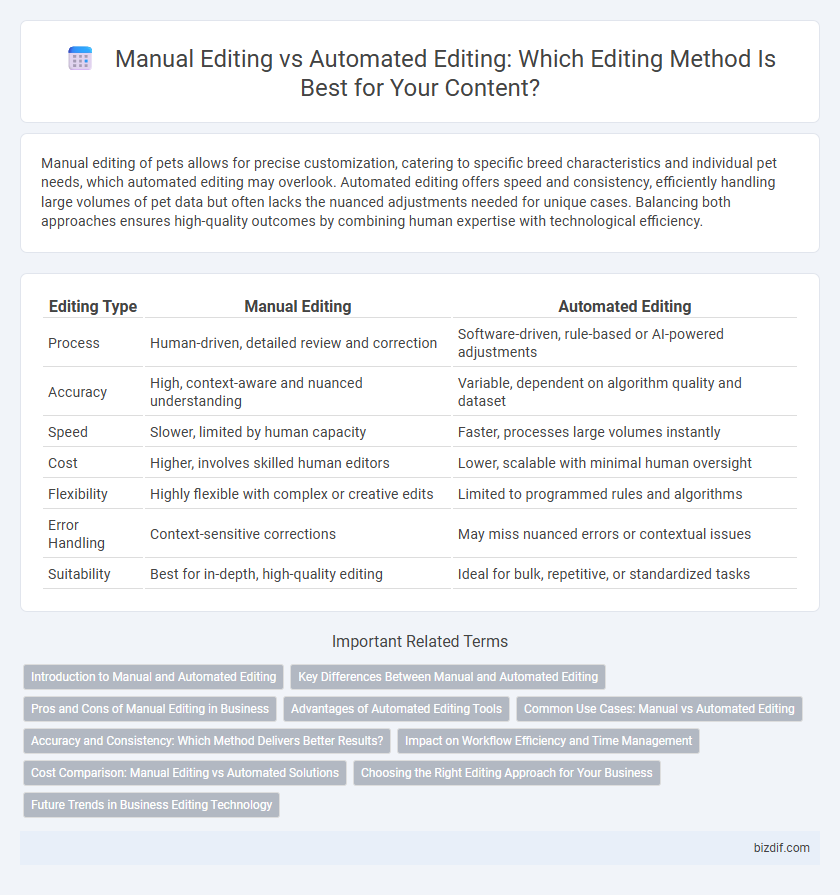Manual editing of pets allows for precise customization, catering to specific breed characteristics and individual pet needs, which automated editing may overlook. Automated editing offers speed and consistency, efficiently handling large volumes of pet data but often lacks the nuanced adjustments needed for unique cases. Balancing both approaches ensures high-quality outcomes by combining human expertise with technological efficiency.
Table of Comparison
| Editing Type | Manual Editing | Automated Editing |
|---|---|---|
| Process | Human-driven, detailed review and correction | Software-driven, rule-based or AI-powered adjustments |
| Accuracy | High, context-aware and nuanced understanding | Variable, dependent on algorithm quality and dataset |
| Speed | Slower, limited by human capacity | Faster, processes large volumes instantly |
| Cost | Higher, involves skilled human editors | Lower, scalable with minimal human oversight |
| Flexibility | Highly flexible with complex or creative edits | Limited to programmed rules and algorithms |
| Error Handling | Context-sensitive corrections | May miss nuanced errors or contextual issues |
| Suitability | Best for in-depth, high-quality editing | Ideal for bulk, repetitive, or standardized tasks |
Introduction to Manual and Automated Editing
Manual editing involves human editors who review and refine content by focusing on context, tone, and nuanced language details, ensuring accuracy and consistency. Automated editing leverages AI-powered tools and software that quickly detect grammatical errors, spelling mistakes, and formatting issues, enhancing efficiency and speed. Both methods serve unique roles, with manual editing emphasizing quality and creativity, while automated editing supports rapid initial corrections.
Key Differences Between Manual and Automated Editing
Manual editing involves human review, ensuring nuanced understanding and contextual accuracy, while automated editing relies on software algorithms for speed and consistency. Key differences include the flexibility of manual editing to handle complex language subtleties versus the efficiency and error detection capabilities of automated tools. Automated editing frequently identifies grammar, spelling, and punctuation errors rapidly, whereas manual editing excels in evaluating tone, style, and overall coherence.
Pros and Cons of Manual Editing in Business
Manual editing in business ensures precise control over content quality, allowing editors to detect nuanced errors and maintain brand voice consistency. This approach can be time-intensive and costly, potentially slowing down project timelines compared to automated tools. However, manual editing reduces the risk of overlooking context-specific mistakes that automated systems might miss, which is critical for maintaining professional communication standards.
Advantages of Automated Editing Tools
Automated editing tools offer significant advantages by enhancing speed and consistency in text refinement, reducing human error through advanced algorithms that detect grammar, punctuation, and style issues. These tools provide real-time suggestions, enabling efficient large-scale editing projects and supporting various languages and formats. Integration with content management systems and cloud platforms facilitates seamless collaboration and version control, optimizing the editorial workflow.
Common Use Cases: Manual vs Automated Editing
Manual editing excels in tasks requiring nuanced judgment, such as creative writing, tone adjustments, and context-specific content refinement. Automated editing is ideal for repetitive, rule-based corrections like grammar, spelling, punctuation, and formatting consistency across large documents. Combining both methods enhances efficiency by leveraging human expertise for complex edits and automation for error detection and standardized corrections.
Accuracy and Consistency: Which Method Delivers Better Results?
Manual editing offers high accuracy through human judgment and contextual understanding, capturing nuances that automated tools might miss. Automated editing ensures unparalleled consistency by applying uniform rules across large volumes of text, minimizing human error and fatigue. Combining both methods often results in optimal outcomes, leveraging the precision of manual review with the scalability of automated processes.
Impact on Workflow Efficiency and Time Management
Manual editing allows for nuanced, context-sensitive corrections that enhance content quality but often requires significant time and effort, potentially slowing workflow efficiency. Automated editing tools streamline the process by quickly identifying and correcting common errors, drastically reducing turnaround time and improving overall time management. Integrating both methods can optimize workflow by balancing precision with speed, leading to more efficient content production.
Cost Comparison: Manual Editing vs Automated Solutions
Manual editing often involves higher labor costs due to the time-intensive process requiring skilled editors, whereas automated solutions significantly reduce expenses by processing large volumes quickly with minimal human intervention. Software-based editing tools offer scalable pricing models, making them cost-effective for repetitive tasks and bulk projects. However, manual editing may still incur higher costs but delivers superior accuracy and nuanced content refinement that automation may miss.
Choosing the Right Editing Approach for Your Business
Selecting the optimal editing approach depends on your business's specific needs, budget, and desired quality. Manual editing offers nuanced, context-aware corrections ideal for complex content requiring a human touch, while automated editing provides fast, cost-effective solutions for straightforward tasks. Evaluating the volume and type of content, alongside turnaround time expectations, ensures efficient and accurate editing tailored to your business goals.
Future Trends in Business Editing Technology
Automated editing technology is rapidly advancing with AI-driven tools enhancing accuracy and efficiency in business document processing. Machine learning algorithms can now identify context-specific errors and suggest improvements beyond basic grammar checks, transforming traditional manual editing workflows. Future trends indicate a hybrid approach where human editors collaborate with AI to deliver higher-quality, faster, and more cost-effective business content.
Manual editing vs automated editing Infographic

 bizdif.com
bizdif.com